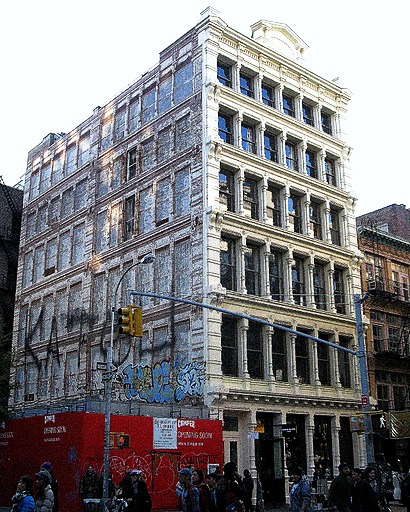 |
| photo by Alice Lum |
On August 25, 1885 The American Architect and Building News noted that Mssrs L. Sachs & Bro. would be building a five-story brick warehouse with “iron front” at No. 26 West Houston Street. The building, which would cost the firm $30,000, was to be designed by Richard Berger.
L. Sachs & Brothers was a highly successful importer and dealer in furs and skins. In the 1880s the quality of fur in a man’s hats or a woman’s coat and trimmings was a mark of social status. The warehouse had become necessary for Sachs' enormous inventory. The Fur Trade Review remarked in 1887 that Messrs. L. Sachs & Brothers “always carry a full stock of seal skins, raw, dressed and dyed beaver, otter, and an exceptionally complete assortment of fine nutria; there has been a large demand for the better grades of the latter article.”
The fur dealers were apparently pleased with the work of their architect because on April 20, 1889 the Engineering and Building Record announced plans by L. S. Sachs for a new building at 112-114 Prince Street. The architect would again be Richard Berger.
The six-story loft building was completed by August of that year, when the Fur Trade Review mentioned that “Messrs. L. Sachs & Brothers are fully settled in their new establishment 112 and 114 Prince Street.”
Berger had designed a clean “neo-Grec” façade not overly-encumbered by ornamentation. Slim, free-standing columns separated each set of windows at all six floors. The architect treated each story identically, but slightly lessening the height of each succeeding floor; creating the illusion of a taller building. While undeniably utilitarian, the structure was light and airy with factory space washed in daylight. Crowning it all was a cast iron parapet with a sunburst motif.
 |
| Berger finished off the design with a sunburst in the parapet -- photo by Alice Lum |
Along with Sachs, other apparel manufacturers moved into the building. Weisl Brothers, cloak makers, was already having problems with the Cloak Manufacturers’ Association in August 1890. Weisl Brothers did not hire union workers, so the Association attempted to compel the firm to advance wages of from 50 to 75 percent to the employees. Mr. Weisl found the advances “exorbitant” and was faced with a strike.
Tensions between union apparel workers and owners continued for years. On July 31, 1896 eighty cloakmakers went on strike after being fined 50 cents each for using cotton thread instead of silk in certain garments. (It was common practice for garment workers to supply their own needles and thread as a condition of their employment.) The employees denied switching thread and when a Cloakmakers’ Union representative arrived to examine the garments, he was refused entry.
In April 1913 James Thompson & Company leased the entire building “for a long term of years.” The firm manufactured twine, mosquito, netting, tarlatans and buckram (stiff woven fabrics, usually used as interlining). Thompson employed 230 workers and would remain in the building for decades.
Around the same time the Garner Print Mill was here printing fabrics; Julius Buchman, also in the twine and netting business, was here for twenty years; and another twine and cordage company, Yazoo Mills leased space in the 1920s.
By the 1970s Soho experienced a renaissance as artists flocked to the relatively cheap open loft spaces with sumptuous amounts of natural light. Galleries sprung up at street level and trendy shops appeared. The top floors of No. 112 Prince were leased out to living and studio spaces for artists, including Maya Lin who created the Viet Nam Memorial in Washington DC.
Above the one-story corner building at Prince and Greene Street the crude unfinished brick side wall of No. 112 rose in stark contrast to its white-painted cast iron Victorian façade. Artist Richard Hass, along with a friend, put forward the idea of a trompe l’oeil mural mimicking the Richard Berger façade.
 |
| The mural not long after completion. Haas included air conditioners and open windows in his work -- photo RichardHaas.com |
 |
| Actual windows melt into the trompe l'oeil facade -- photo by Alice Lum |
 |
| For over three decades Haas' window cats have watched over Greene Street -- photo by Alice Lum |
 |
| The cost to carefully remove the spray painted damage of vandals is considerable -- photo by Alice Lum |

.png)

Thankfully the mural was restored in 2024. Graffiti free!
ReplyDelete